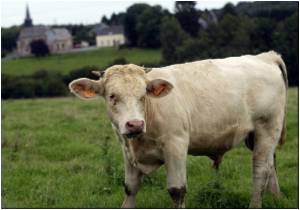Even waste treatment systems that are considered to be state-of-the-art often fail to account for chemicals used routinely in modern society.

‘Despite having advanced system for waste disposal on a dairy farm, researchers observed that chemicals largely persisted in the treated materials, which are reused as fertilizer and animal bedding on the farm.’





The waste management process - an advanced anaerobic digestion system - also converted a less harmful form of estrogen in the manure into a form that may pose a greater ecological threat. The study underscores how far waste treatment techniques have fallen behind the times. "Even waste treatment systems that are considered to be state-of-the-art often fail to account for chemicals used routinely in modern society," said University at Buffalo researcher Diana Aga, who led the new study. She is a professor of chemistry in the UB College of Arts and Sciences and a member of UB RENEW (Research and Education in eNergy, Environment and Water), an institute that addresses complex environmental issues.
Aga said, "The chemicals we are studying are not exotic. Antibiotics are used to treat sick animals, and the cows on a dairy farm are females, so they produce a lot of estrogens. One of the messages of our work is that even anaerobic digestion, an advanced treatment, doesn't totally remove these chemicals which may pose a danger to the environment. We need to start looking closely at additional treatment techniques to identify better practices."
The research, funded by the New York State Pollution Prevention Institute, was published in two recent papers. The first, on antibiotics, appeared in the Journal of Environmental Quality. The second, on estrogens, was published in the journal Science of the Total Environment.
The farm where Aga and her colleagues conducted their research is a commercial dairy farm with about 2,000 cows.
Advertisement
Aga's team measured levels of veterinary antibiotics and estrogens in the waste at various points during the treatment process.
Advertisement
Aga said, "When it came to estrogens, we had hypothesized that the digestion process would remove the hormones, but it didn't. Instead, the total concentration of estrogens remained relatively steady. In addition, the treatment process appeared to convert a less harmful form of estrogen into one with greater potential for disrupting the function of animals' endocrine systems, which produce hormones that regulate growth, reproduction and other biological functions." Prior to anaerobic digestion, most of the estrogens in the manure (65%) were in a form with lower endocrine-disrupting potential. After the process, 72% of the estrogens were in a form with higher endocrine-disrupting potential.
Aga notes that each farm has a unique system for processing waste, so it's possible that a different anaerobic digestion technique or a completely different treatment method could yield better results. The next step in the research will be to explore various treatment techniques to identify best practices.
Aga said, "When it comes to manure treatment, there are a lot of variables to explore - how much time the manure is treated for during anaerobic digestion, whether the manure is mixed with food waste or not, or whether the digested product is further composted or treated by other means. For farms using long-term storage, it may also matter if the lagoons are covered up or not. We need to do more research to find out."
Source-Eurekalert















